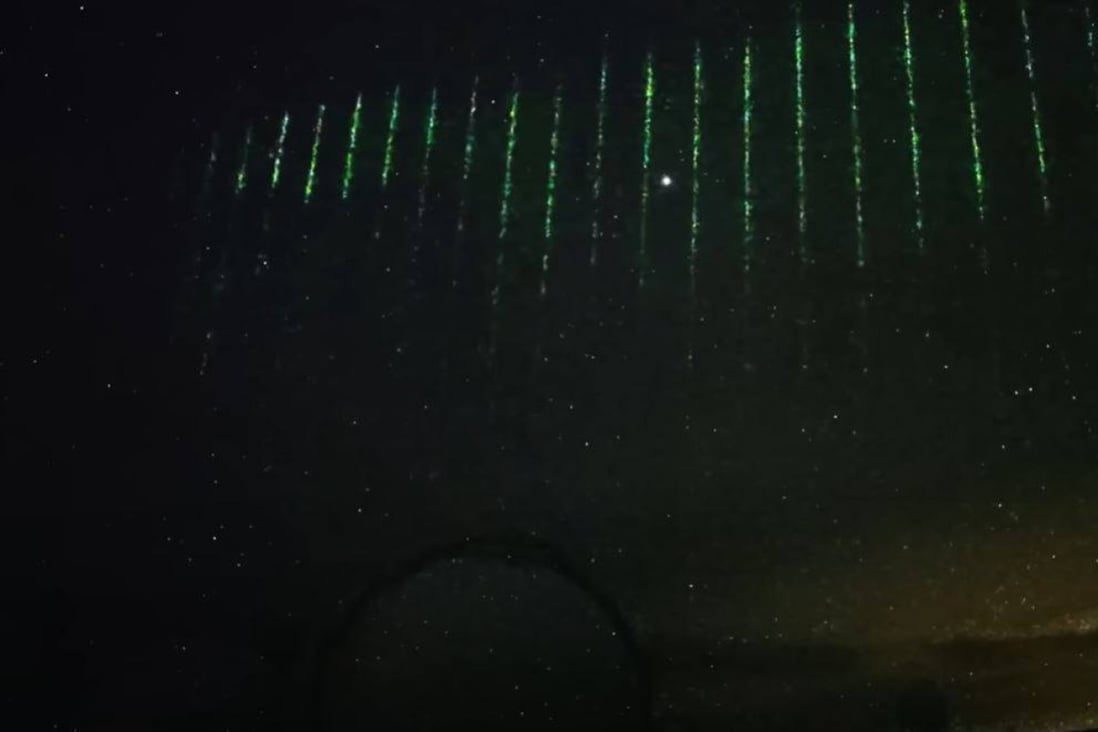On January 28, a camera from a telescope on Mauna Kea, Hawaii’s tallest peak, photographed what seemed to be a curtain of blazing green lasers floating across the island’s night sky.
Japanese astronomers believe a Chinese weather satellite was responsible for beaming down green laser flashes.
The National Astronomical Observatory of Japan first shared a video of a string of lights that resembled the green code from The Matrix on January 28.
Initially, the organization’s researchers said that the topographic laser caused the light show on NASA’s ICESAT-2 satellite, which is employed to monitor sea ice and forests.
However, NOAJ updated its YouTube description, stating that NASA’s satellite was not the source of the lasers over Hawaii. The updated video identified a Chinese Daqi-1/AEMS satellite launched a year ago as “the most likely candidate.”
The China Aerospace Science and Technology Corporation stated in a news release from 2021 that the Daqi-1/AEMS satellite is used to detect nitrogen dioxide, sulfur dioxide, and ozone in addition to carbon dioxide.
Dr. Anthony J. Martino, a NASA scientist working on ICESat-2 ATLAS, was quoted in the video description as indicating that the light show was not caused by their instrument but by others.
His colleagues, Dr. Alvaro Ivanoff et al., ran simulations of the satellite trajectories carrying instruments of a similar nature and identified the Chinese Daqi-1/AEMS satellite’s ACDL instrument as the most likely option.
“We really appreciate their efforts in the identification of the light. We are sorry about our confusion related to this event and its potential impact on the ICESat-2 team,” the update stated.
Another eerie sight was seen in the night sky over Hawaii earlier in January. According to the media reports, the launch of a new Space X satellite was the origin of a mysterious blue light in the form of a vortex hovering among the stars.

This innocuous update gained attention online after two airships were shot out of the sky by F-22s in the past week. According to Pentagon authorities, one of the items was a balloon used by China to spy on the US. Officials in China asserted that it was a weather balloon.
The Biden administration said it was built to intercept communication on the ground as it traveled from Montana to the east coast at 60,000 feet over US airspace.
On January 10, an F-22 downed an unidentified airship flying 40,000 feet above Alaska. Its origin and function are unknown. According to US officials, the object might be dangerous for commercial planes.
Chinese Daqi-1 Satellite
Similar to ICESat-2, the Chinese Daqi-1 satellite was launched in April last year to study the atmosphere. That indicates that it is orbiting the planet to keep an eye on atmosphere pollution and the level of carbon in the atmosphere.
To accomplish this, Daqi-1 is equipped with five instruments: the ACDL—Aerosol and Carbon Dioxide Detection Lidar.
The term “Lidar” stands for laser imaging, detection, and ranging, and it functions somewhat similarly to sonar. However, it uses laser beams to map the area rather than sound waves.
And it is thought that these lasers illuminated the sky over Hawaii at the end of January. With regard to ACDL, it is capable of launching dual-wavelength lasers at particular wavelengths to find distinct compounds in the Earth’s atmosphere.
The amount of time it takes for these laser beams to bounce back reveals details about the atmosphere and Earth below. For instance, by generating two alternating lasers in the 1572 nanometer wavelength range, ACDL can determine how much Co2 is in the Earth’s atmosphere.

The China Aerospace Science and Technology Corporation, which produced Daqi-1, stated in a news release from March 2021 that Daqi-1 “Daqi-1 can monitor fine particle pollution like PM2.5, pollutant gasses including nitrogen dioxide, sulfur dioxide, and ozone, as well as carbon dioxide concentration.”
In the future, China will launch a number of Daqi satellites that will be used to track atmospheric pollution, support environmental authorities with remote sensing data, and aid scientific investigations into global climate change.
Daqi-1 will be coupled to other satellites, such as Daqi-2, to monitor greenhouse gases and aid China in reducing carbon emissions.
- Contact the author at ashishmichel(at)gmail.com
- Follow EurAsian Times on Google News




